
- 114 pages
- English
- ePUB (mobile friendly)
- Available on iOS & Android
eBook - ePub
About this book
MS Excel is one of the most powerful tools available to a business manager. In this book, the author provides an advanced level of skill sets and brings actionable insights to the user. Hence, the material in this version has been organized as follows: Financial functions; Conditional math and statistical functions; Data analysis; Decision making; Data cleaning and use of macros; Auditors.
The objective is to give readers a flavor of how the vast array of functions can be used to make life easier and more efficient. Amazing results can be achieved by mastering Excel at a basic level. Readers who execute the given functions on a workbook simultaneously and experience the journey will find the learning curve the steepest.
Frequently asked questions
Yes, you can cancel anytime from the Subscription tab in your account settings on the Perlego website. Your subscription will stay active until the end of your current billing period. Learn how to cancel your subscription.
No, books cannot be downloaded as external files, such as PDFs, for use outside of Perlego. However, you can download books within the Perlego app for offline reading on mobile or tablet. Learn more here.
Perlego offers two plans: Essential and Complete
- Essential is ideal for learners and professionals who enjoy exploring a wide range of subjects. Access the Essential Library with 800,000+ trusted titles and best-sellers across business, personal growth, and the humanities. Includes unlimited reading time and Standard Read Aloud voice.
- Complete: Perfect for advanced learners and researchers needing full, unrestricted access. Unlock 1.4M+ books across hundreds of subjects, including academic and specialized titles. The Complete Plan also includes advanced features like Premium Read Aloud and Research Assistant.
We are an online textbook subscription service, where you can get access to an entire online library for less than the price of a single book per month. With over 1 million books across 1000+ topics, we’ve got you covered! Learn more here.
Look out for the read-aloud symbol on your next book to see if you can listen to it. The read-aloud tool reads text aloud for you, highlighting the text as it is being read. You can pause it, speed it up and slow it down. Learn more here.
Yes! You can use the Perlego app on both iOS or Android devices to read anytime, anywhere — even offline. Perfect for commutes or when you’re on the go.
Please note we cannot support devices running on iOS 13 and Android 7 or earlier. Learn more about using the app.
Please note we cannot support devices running on iOS 13 and Android 7 or earlier. Learn more about using the app.
Yes, you can access MS Excel, Second Edition by Anurag Singa in PDF and/or ePUB format, as well as other popular books in Économie & Comptabilité & budgets. We have over one million books available in our catalogue for you to explore.
Information
CHAPTER 1
Excel for Personal Financial Decisions
PV and FV
Excel has several financial functions:
A) The PV (Present Value) function calculates the total present (current) value of an investment with a fixed rate, specified number of payment periods, and a series of identical payments that will be made in the future.
B) The FV (Future Values) function calculates the future value of an investment, given a fixed interest rate, term, and identical periodic payments.
C) The NPV (Net Present Value) function calculates the net present value of an investment, given a fixed rate (rate of return) and future payments that may be identical or different.
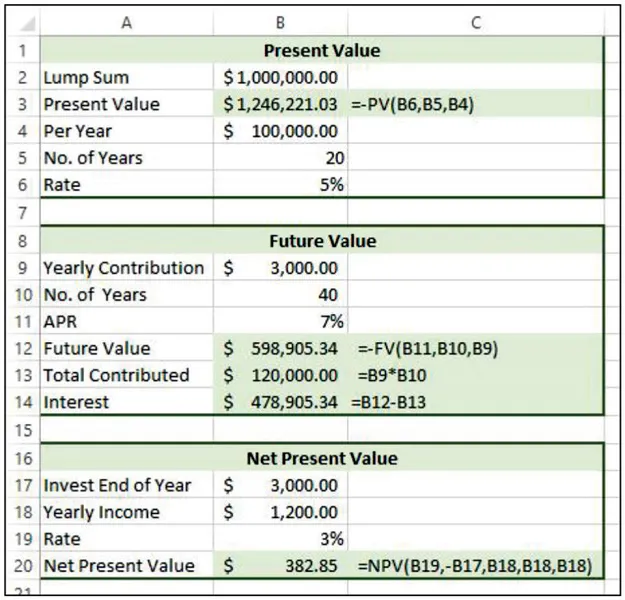
Internal Rate of Return (IRR)
This returns the internal rate of return for a series of cash flows represented by the numbers in values. These cash flows do not have to be even, as they would be for an annuity. However, the cash flows must occur at regular intervals, such as monthly or annually. The internal rate of return is the interest rate received for an investment consisting of payments (negative values) and income (positive values) that occur at regular periods.
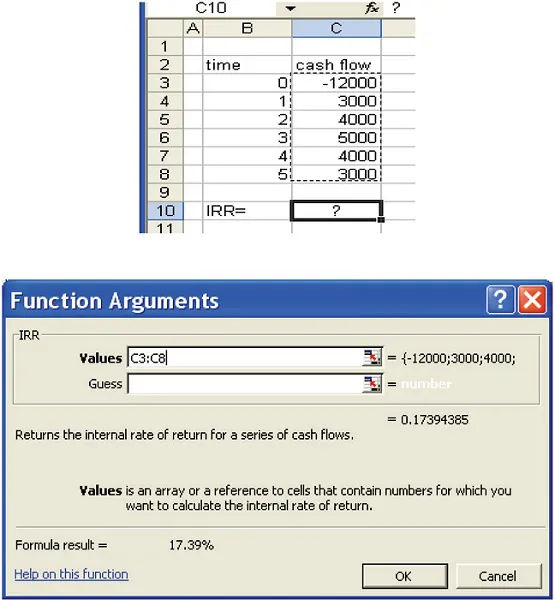
Determine # Periods in Bond Problem
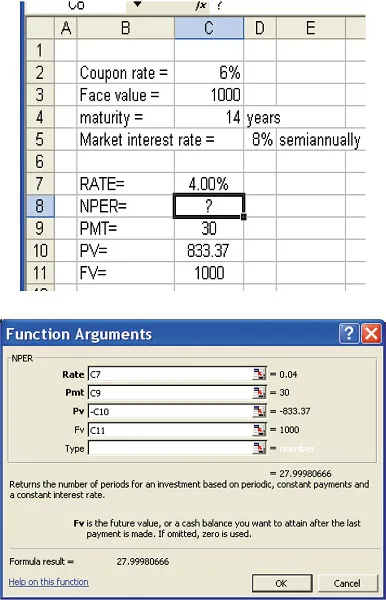
Yield to Maturity
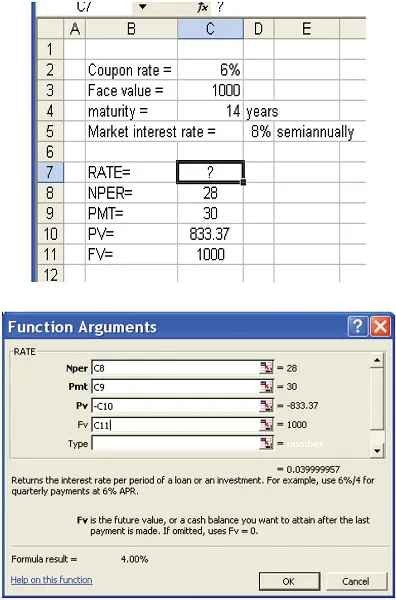
NPER and RATE
The NPER (Number of PERiods) function calculates the number of payment periods for an investment or loan given a fixed interest rate, periodic payment, and present value.
The RATE function calculates the periodic rate for an investment or loan given the number of payment periods, a fixed periodic payment, and present value.
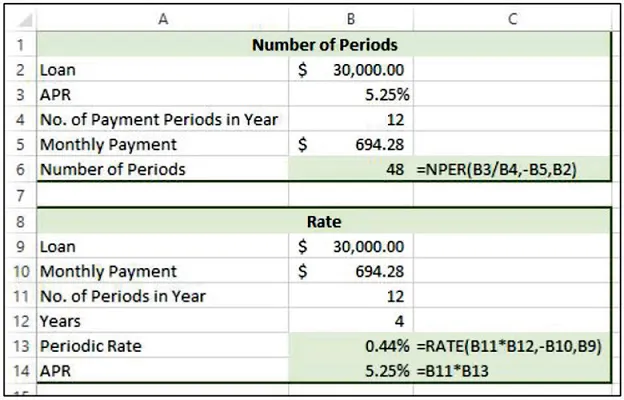
This slide shows specific examples of how the number of periods (NPER) and rate (RATE functions) have been applied in a worksheet.
Create a Loan Amortization Table
Suppose you want to create a payment schedule that shows the interest per payment period, principal repayment for each payment, and the balance after each payment is made. This is called a loan amortization table, and a partial table is shown in the slide. Because this example is for a car loan over 4 years or 48 monthly payments, the complete schedule cannot be viewed in its entirety.
Let’s look at the financial functions that are needed to generate this amortization table.
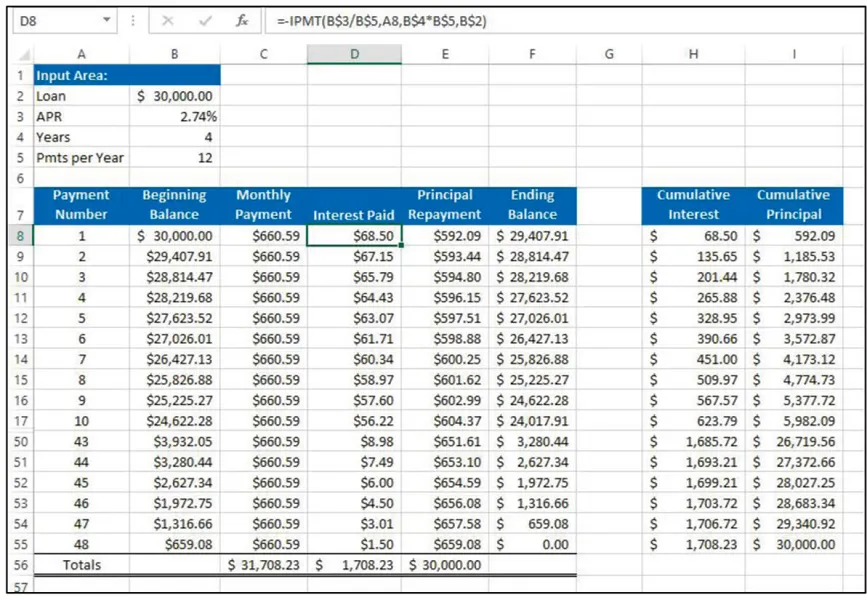
IPMT
The IPMT function calculates the periodic interest for a specified payment period on a loan or an investment given a fixed interest rate, specified term, and identical periodic payments.
=IPMT(rate,per,nper,pv,[fv],[type])
The PPMT function calculates the principal payment for a specified payment period on a loan or an investment given a fixed interest rate, specified term, and identical periodic payments.
=IPMT(rate,per,nper,pv,[fv],[type])
The arguments for these two functions are:
A) The rate argument is the periodic interest rate. If the APR is 6 percent and the payments are made monthly, then the rate is 6 percent/12 or 0.5 percent.
B) The per argument is the specific payment or investment period to use to calculate the interest where the first payment period is 1.
C) The nper argument represents the total number of payment or investment periods. With a 4-year loan consisting of monthly payments, the number of payment periods is 48.
D) The pv argument represents the present value of the loan or investment.
E) The optional fv argument represents the future value of the loan or investment. If you omit this argument, Excel defaults to 0.
F) The optional type argument represents the timing of the payments. Enter 0 if the payments are made at the end of the period, or enter 1 if the payments are made at the beginning.
Cumulative Calculation Functions
• The CUMIPMT function calculates the cumulative interest through a specified payment period.
=CUMIPMT(rate,nper,pv,start_period,end_period,type)
=CUMIPMT(rate,nper,pv,start_period,end_period,type)
• The CUMPRINC function calculates the cumulative principal through a specified payment period.
=CUMPRINC(rate,nper,pv,start_period,end_period,type)
=CUMPRINC(rate,nper,pv,start_period,end_period,type)
The only two new arguments are the start_period argument, which specifies the first period you want to start accumulating the interest, and the end_period argument, which specifies the last payment period you want to include.
The amortization table is shown once again so you can see how the various functions were applied.
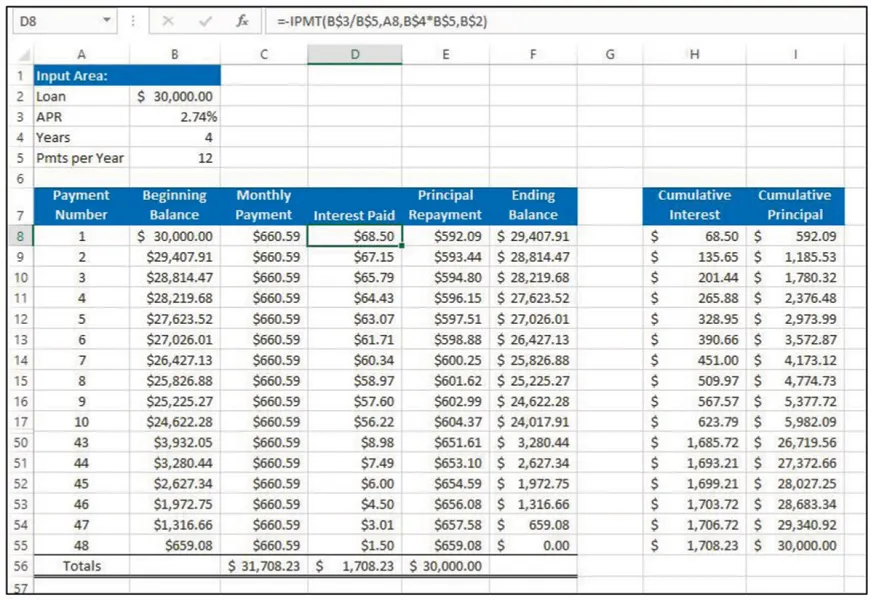
CHAPTER 2
Excel for Conditional Math and Statistical Functions
As against specialist software packages for statistical analysis like SPSS, R, SAS, and Minitab, the reason we often use Excel for statistical analysis is
A) Convenience as it’s already installed on our PCs. It is to be noted that unless the statistical computational needs are highly advanced, for beginners Excel is quite user-friendly and eliminates the need to learn another software. Excel also integrates easily into other Microsoft Office software prod...
Table of contents
- Cover
- Title Page
- Copyright Page
- Contents
- Preface
- Acknowledgments
- Chapter 1 Excel for Personal Financial Decisions
- Chapter 2 Excel for Conditional Math and Statistical Functions
- Chapter 3 Excel for Data Analysis
- Chapter 4 Excel for Decision Making
- Chapter 5 Excel for Data Dashboards and Visualization
- Chapter 6 Excel for Data Cleaning and Use of Macros
- Chapter 7 Excel for Auditors
- About the Author
- Index